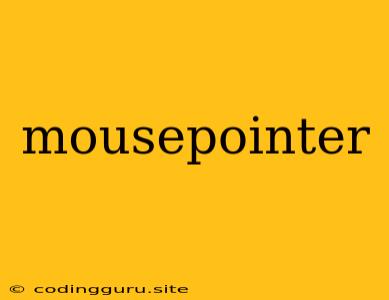The Intricate World of the Mouse Pointer
The mouse pointer, a seemingly simple yet essential element of the digital world, plays a crucial role in our interaction with computers. This small, often inconspicuous icon on our screens acts as our visual guide, facilitating our navigation and interaction with applications, websites, and files. But have you ever stopped to think about the intricate design and functionality that goes into making this seemingly simple tool so effective?
What is a Mouse Pointer?
In essence, the mouse pointer is a graphical representation of the user's cursor position on the screen. It serves as a visual feedback mechanism, allowing users to see exactly where their actions will be executed. The pointer's shape and appearance can change depending on the context, providing additional information about the current state of the system.
The Evolution of the Mouse Pointer
The mouse pointer has undergone a significant evolution since its inception. Early computers often displayed simple shapes, such as an arrow or a block, to indicate cursor location. However, as graphical user interfaces (GUIs) became more sophisticated, the mouse pointer became increasingly complex. Today, we encounter a diverse array of mouse pointer styles, each designed to enhance user experience and convey specific functionalities.
Types of Mouse Pointers
Here's a glimpse into the diverse world of mouse pointers:
- Arrow: The ubiquitous arrow pointer is the most common and recognizable mouse pointer type. It signifies that the user can select or interact with various objects on the screen.
- I-beam: Often used for text editing, the I-beam pointer indicates that the user can insert text at a particular location within the document.
- Hand: The hand pointer signifies a clickable element, such as a hyperlink or a button, encouraging users to click for interaction.
- Hourglass: This pointer, often displayed as a spinning hourglass, indicates that the system is busy processing a task and the user should wait.
- Crosshair: Used in applications like graphic design and photo editing, the crosshair pointer helps users precisely position objects or make selections.
Why Different Shapes Matter
The variety of mouse pointer shapes is not arbitrary. Each shape serves a specific purpose and contributes to the overall usability of the interface. For instance, the I-beam clearly indicates that the user is interacting with text, while the crosshair pointer signals precise positioning within a visual environment. These subtle design cues help users quickly understand the context of their actions and navigate the digital landscape efficiently.
Customization and Personalization
Many operating systems and applications allow users to customize their mouse pointer settings. This includes adjusting the pointer's size, speed, and even its appearance. Some users prefer larger mouse pointers for enhanced visibility, while others may enjoy unique pointer designs to personalize their computer experience.
Beyond the Mouse
While the traditional mouse pointer is primarily associated with a physical mouse, the concept has extended to touch-sensitive screens and other input devices. On tablets and smartphones, the mouse pointer is often represented by a circular dot that follows the user's fingertip. This adaptation ensures seamless navigation and interaction across various platforms.
The Importance of Accessibility
The design of mouse pointers should also consider accessibility for all users. Individuals with visual impairments might need larger or more distinct pointers for clear visibility. Some operating systems offer accessibility features that allow users to customize mouse pointer settings to suit their individual needs.
The Future of the Mouse Pointer
As technology continues to evolve, the mouse pointer will likely undergo further transformations. With the rise of virtual reality and augmented reality, new forms of interaction and feedback will become essential. The mouse pointer, once a simple symbol of cursor location, may evolve into more immersive and interactive elements, enhancing our experience in the digital realm.
Conclusion
The mouse pointer, often overlooked in our digital interactions, is a testament to the power of subtle design elements. Its evolution reflects the growth of computing, its diversity caters to various user needs, and its continued relevance speaks to its importance in our navigation of the digital world. As we continue to explore new frontiers in technology, the mouse pointer will undoubtedly remain a vital part of our digital journey, guiding us through the intricacies of the digital landscape.
